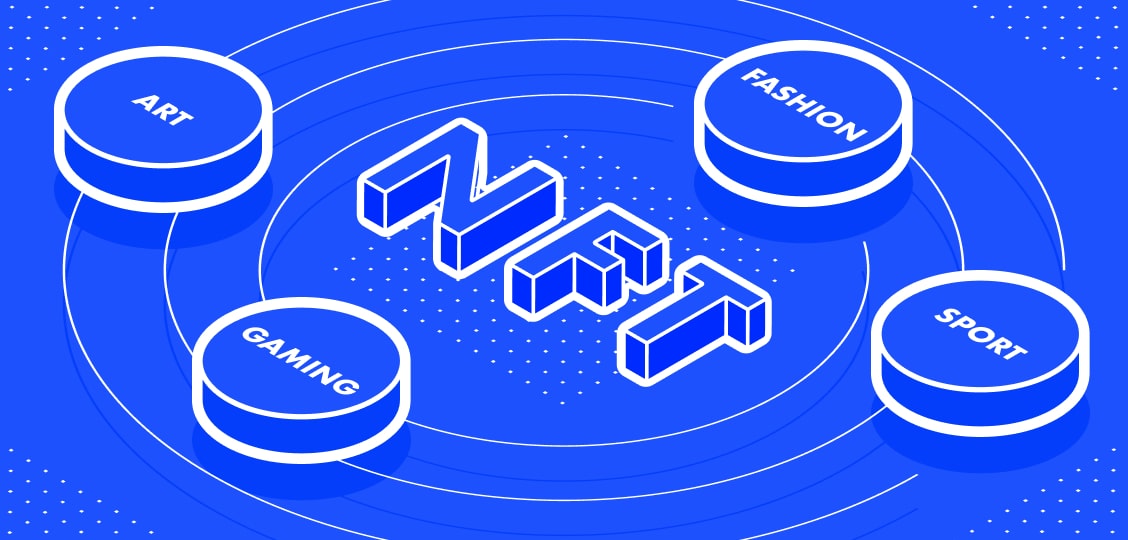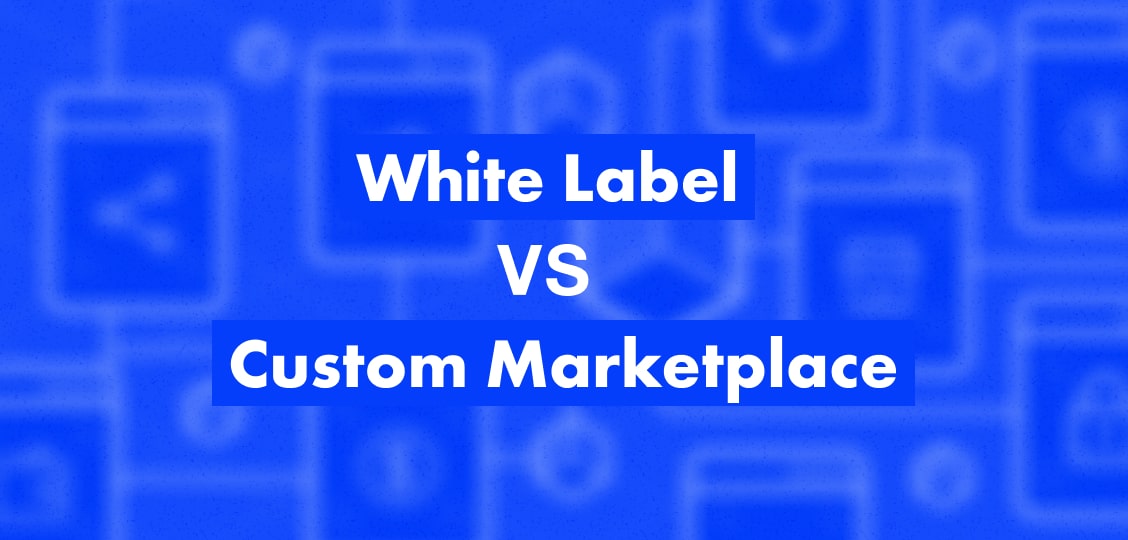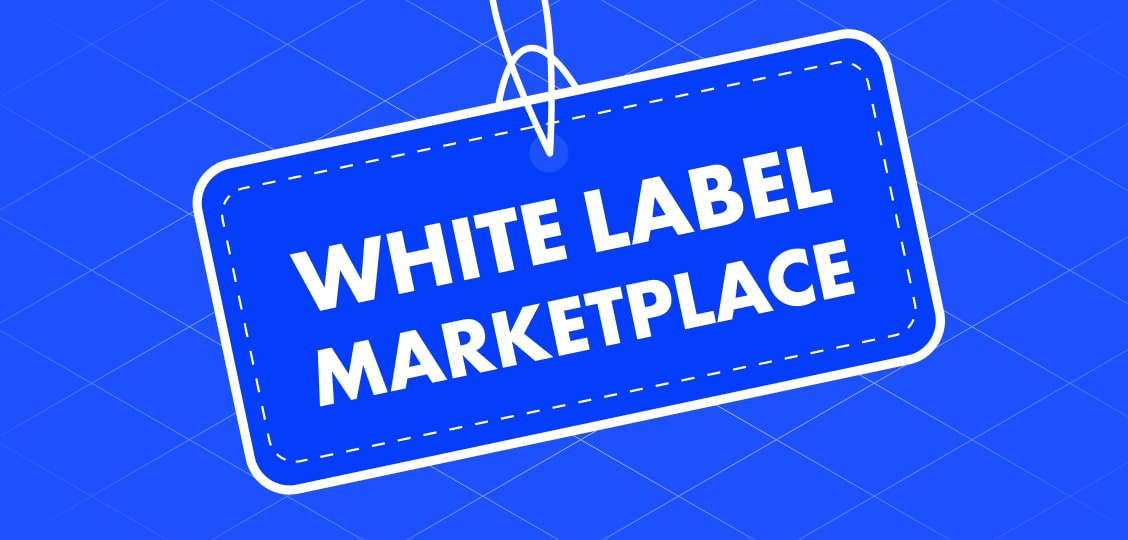Сustom marketplace development vs. white labeling. What should you choose?
Both custom and white label marketplaces have their advantages and disadvantages. Find out which model will better suit your business objectives.

Since NFTs provide an effective, wild new channel to generate sales and engage the audience, the popularity of non-fungible tokens continues to surge. With new NFT use cases coming into play, brands and individuals across numerous sectors create their own digital artworks to attract new generations of customers and gain recognition while bypassing third parties like agents, distributors, and galleries.
According to Research and Markets, the worldwide NFT market is anticipated to climb from $14.02 billion in 2021 to $82.43 billion in 2026, progressing at a CAGR of 40.2%. DappRadar.com reports that during the first quarter of 2021, NFTs have generated more than $1.5 billion value of transactions, showcasing 2,627% quarter-over-quarter growth.
The increasing entry of the globally leading companies, such as Microsoft, Nike, Starbucks, Coca Cola, Tesla, Gucci, and Home Depot, as well as the tokenization appeal through cryptocurrencies are the key driving factors.
Morning Consult revealed that 51% of physical collectors state they will be either “very” or “somewhat” interested in buying NFTs in the future.
Furthermore, Morning Consult reports that millennials sell and purchase NFTs three times more often than Gen Z. Therefore, although the NFT market is relatively new, it has good prospects and opportunities for digital artists and investors.
With considerable experience in blockchain software and, particularly, non-fungible token marketplace development, we have collected the top NFT use cases for 2022. Continue reading the article to find ideas for your project.
There are numerous use cases of NFTs across different sectors, including fashion. As fashion and blockchain technology are combined together, the industry is seeing a rapid transformation. World-famous brands are striving to meet the increasing demand for digital clothing, with major players like Adidas and Dolce & Gabbana designing their own NFTs.
For instance, Ralph Lauren introduced its digital apparel collection in August 2021. For this purpose, the corporation partnered with Zepeto, which is the most popular metaverse among Generation Z, to create a fully articulated virtual world where users have personalized 3D avatars and wardrobe them with exclusive products.
On September 30, 2021, Dolce & Gabbana announced that it sold a nine-piece fashion collection—consisting of both real outfits and their NFT doubles—for about $5.7 million. In March 2021, the startup RTFKT Studios managed to sell over 600 pairs of virtual sneaker collectibles, reaching a total of more than $3.1 million.
Aiming to engage fans, companies are increasingly introducing sports collectibles, which is one of the most trending NFT use cases for 2022. The digital expansion of non-fungible tokens offers innovative opportunities that were missed in the physical world. Thanks to NFTs, users can collect virtual merch, tickets to various sports events, player cards, autographs of sports stars, and highlights from iconic, unforgettable moments.
Deloitte predicts that by the end of 2022, 4–5 million sports fans around the world will have bought or been gifted an NFT sports item. Experts at Deloitte also forecast that NFTs for sports media will generate over $2 billion in transactions this year, growing by nearly two times compared to 2021.
With NFTs, sports teams, athletes, clubs, and leagues can receive a new source of revenue. As for successful NFT projects in the industry, let’s consider Sorare. Established in 2018, Sorare is a fantasy football game allowing players to trade cards that feature real footballers and are registered on the Ethereum blockchain.
The incorporation of intangible digital assets into the music sector is among the top NFT use cases you should be aware of. Due to blockchain technology, artists can create their songs, soundbites, albums, and lyrics as NFTs. To remove the need for third parties (record labels, agents, etc.), software engineers can write smart contracts in a way that sales or the percentage of each resale go directly to artists.
As musicians are recognizing the advantages of migrating from centralized business models, the demand for NFTs is growing. Well-known musicians who have already introduced NFTs involve Steve Aoki, 2 Chainz, Dolly Parton, Kings of Leon, and G-Eazy.
In 2021, Kings of Leon became the first group to release a music album in the form of an NFT, along with other benefits. For example, Kings of Leon held an auction of six so-called "Golden Tickets," each providing the owner with four front-row seats to a single show of every band’s headlining tour for the rest of their life. The band reported that it has managed to generate more than $2 billion after the first four days of sales.
Snoop Dogg has recently acquired Death Row Records and now is going to turn the company into the first-ever non-fungible token recording label in the Metaverse. In March 2021, Grimes sold $6 million worth of digital artworks at auction through an online NFT marketplace named Nifty Gateway. The collection has 10 pieces for sale, including a short video featuring an original song by Grimes.
Although the hype around NFTs is still gathering pace among music experts, Tia Smith, Grammy governor and co-chair of the Music Video Committee says she can imagine how these tokens will soon be integrated into major live events like the Grammy Awards.
Foodtech companies can use NFTs and Web 3.0 to promote their products and services while increasing brand awareness. Famous chefs, such as Tom Colicchio are making NFT recipes, dishes, limited-edition vine bottles, as well as other items to interact with the audience in a wild new way.
TacoBell, for example, introduced 25 non-fungible tokens in 2021 for celebrating the return of potatoes to the menu. As a result, the organization became the first fast-food business to design NFT. All TacoBell’s NFTs were sold in less than half an hour.
Recently, Gary Vaynerchuk (Chairman of VaynerX and co-founder of a restaurant reservation application), David Rodolitz (co-founder at the Empellón Group in New York City), and Josh Capon (chef of Lure Fishbar) announced that they plan to launch Flyfish Club, the first NFT restaurant in the world. In fact, it is a private dining club that provides membership as an NFT.
Representing a utility-based blockchain project, Flyfish Club allows NFT owners to not just enjoy their membership but sell or lease it. Apart from a fish or sushi-themed token, NFT owners can become members of the restaurant, which is based in New York City. They can also get access to real-life events like Super Bowl parties. Therefore, as opposed to the majority of NFT startups, Flyfish Club offers something tangible instead of delivering digital assets only.
While Flyfish Club will not be officially established until 2023, its initial NFT membership tranches have been already sold out. The company has generated over $14 million on its initial mint, with ongoing sales accounting for a whopping $21 million.
Speaking of other NFT use cases in the domain, chef David Skinner and digital media entrepreneur Ruth McCartney decided to provide chefs with the possibility to sell recipes to customers without intermediaries. For this purpose, they released a so-called Gourmet NFT.
Non-fungible tokens have the potential to innovate the education industry. Students can use NFTs in order to showcase their academic achievements and confirm certifications. What’s more, trainees can employ NFTs as proof of their degrees, class attendance, and other information. Thanks to the blockchain ledger that utilizes cryptographic algorithms, NFT platforms offer a secure place to save and store such data.
With millions of users globally playing blockchain-based games, the demand for NFTs in the sector is rapidly increasing. There are plenty of NFT use cases in gaming. Thanks to this innovation, people can collect, purchase, and sell digital objects, involving weapons, land, and character outfits.
Furthermore, users can take participation in games to earn NFTs and turn them into real money. This may lead to the creation of a new virtual economy powered by blockchain and cryptocurrencies, as well as supported by a strong community of enthusiasts.
Recognizing an opportunity to surpass consumer expectations, attract the audience, and gain a competitive edge, many companies have already released their own NFTs and incorporated digital tokens into their ecosystem.
For instance, a metaverse-style online video game Axie Infinity enables customers to train, raise, and combat so-called Axies virtual creatures. Tokenized as NFT, Axies are stored on the Ethereum blockchain. In order to start playing, users need to buy three Axie NFTs via a specialized marketplace application. The game lets NFT holders earn in-game currency by winning battles or trading Axies.
While most non-fungible tokens are still used to sell digital artworks, there is a variety of NFT use cases beyond art. Brands across various sectors can benefit from NFTs by receiving a new source of income, boosting customer satisfaction, and bringing innovation. In the near future, companies will utilize NFTs to tokenize any real-life assets.
With blockchain, businesses make ownership incorruptible, which is among the key NFT advantages. The rising demand for this technology and the emergence of new NFT applications are expected to be the primary market drivers. Looking ahead, NFTs may become the primary digital touchpoint between vendors and consumers.
If you aim to create an NFT marketplace platform or blockchain-based app that uses tokens of this kind, contact our team. We will get back to you within 1 business day and help address all issues. Project consultation is free of charge.
Additionally, we recommend that you read our guide to building an NFT marketplace like OpenSea, from the key features you should implement to cost and time estimates.

Both custom and white label marketplaces have their advantages and disadvantages. Find out which model will better suit your business objectives.

Find out how white label marketplace development will allow you to improve time to market, reduce expenses, and increase customer loyalty.
Now, you will receive a fresh newsletter from us.
Get the latest scoop on software application tips, announcements, and updates from us. Subscribe to our newsletter!